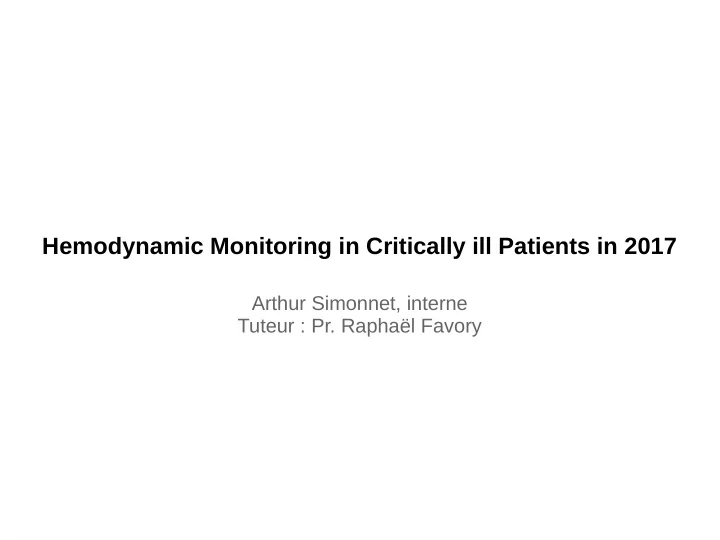

Hemodynamic Monitoring in Critically ill Patients in 2017 Arthur Simonnet, interne Tuteur : Pr. Raphaël Favory
Rationale for Hemodynamic Monitoring Identify the presence of hemodynamic instability Identify the causes of hemodynamic instability Target therapeutic approaches Saugel et al. Critical Care (2016) 20:401
Acute Cardiovascular Impairments Hypovolemia Left and right ventricular dysfunction Abnormalities of vascular tone Microvascular dysfunction ± Respiratory failure Associated with patient chronic comorbidities Saugel et al. Critical Care (2016) 20:401
Algorithm for the choice of hemodynamic monitoring Teboul et al. Intensive Care Med. 2016;42
Central venous catheter : − Central Venous Pressure (CVP) − ScvO2 − PvCO2 Rivers et al. N Engl J Med 345 (2001) Eskesen et al. Intensive Care Med 42 (2016)
Clinical assessment : essential but limited − Skin : degree of cutaneous perfusion − Kidneys : urine output − Brain : mental status Saugel et al. J Crit Care 26 (2011) Perel et al. J Clin Monit Comput (2015)
Lactate measurement : − Shock diagnosis − Lactate monitoring to guide therapy ? Jansen et al. Am J Respir Crit Care Med 182 (2010)
Echocardiography : − Systolic and diastolic ventricular functions − Valvular competency − Diagnose / exclude obstructive shock − Cardiac output − Diagnostic or monitoring tool ?
Arterial catheter : − Systolic arterial pressure : left ventricular afterload − Diastolic arterial pressure : indicator of arterial tone − Mean arterial pressure : determinant of organ perfusion pressure − Pulse pressure : indicator of stroke volume − CO2 gap − Pulse pression variation − Repeated blood sampling
Arterial catheter : − Arterial pulse contour analysis Left ventricular stroke volume Arterial impedance Cardiac output changes induced by therapeutic tests FloTrac, LiDCOrapid, ProAQT Slagt et al. Br J Anaesth 112 (2014)
Algorithm for the choice of hemodynamic monitoring Teboul et al. Intensive Care Med. 2016;42
Transpulmonary thermodilution systems : − PiCCO : i) Cardiac output ii) Global end-diastolic volume iii) Cardiac function index and global ejection fraction iv) Extra-vascular lung water v) Pulmonary vascular permeability index − Volume View Monnet et al. Crit Care 15 (2011) Saugel et al. J Crit Care 26 (2011) Jozwiak et al. Crit Care Med 41 (2013)
Pulmonary artery catheter (PAC) : − Declining use − Valuable if correct measurement, correct data interpretation, and correct application − Severe right ventricular dysfunction +++ Binanay et al. JAMA (2005) ESCAPE Harvey et al. LANCET (2005) PAC-Man Wiedemann et al. NEJM (2006) FACTT Saugel et al. J Crit Care 26 (2011) Perel et al J Clin Monit Comput (2015) Gnaegi et al. Crit Care Med 25:213–220 (2007) Vincent et al. Crit Care Med 36 (2008) Rajaram et al. Cochrane Database Syst Rev 2 (2013)
Other Hemodynamic Techniques Esophageal doppler Real-time estimation of blood flow in the descending aorta Assumption of equal distribution between upper and lower territories Estimation of the diameter of the descending aorta Dark et al. Intensive Care Med 2004 Hamilton et al. Anesth Analg 2011
Other Hemodynamic Techniques Continuous analysis of the arterial pressure waveform − Radial artery applanation tonometry Limitation : impairment of the signal by sensor movement − Volume clamp method CLEARSIGHT Limitation : severe vascoconstriction, peripheral edema Impedance Cardiography (Bioz) Bioreactance (NICOM) Pulse wave transit time method (essCO)
Other Hemodynamic Techniques Teboul et al. Intensive Care Med. 2016;42
Hemodynamic Monitoring in the Era of Evidence Based Medicine Hemodynamic Monitoring as a way to minimize uncertainties concerning hemodynamic status Shortcomings of Evidence Based Medecine in the field of hemodynamic monitoring − Heterogeneous patient populations − « One size fits all » approach Shortcomings of hemodynamic monitoring − Data interpretation, limitations, confounding factors − Make the right intervention Saugel et al. Critical Care (2016) 20:401
Future of Hemodynamic Monitoring Visualization of complex information Processing of hemodynamic data Monitoring of the microcirculation : the hemodynamic coherence concept Michard Ann Intensive Care 6 (2016) Ince Crit Care 2015;19
Ince Crit Care 2015;19
Ince Crit Care 2015;19
Recommend
More recommend